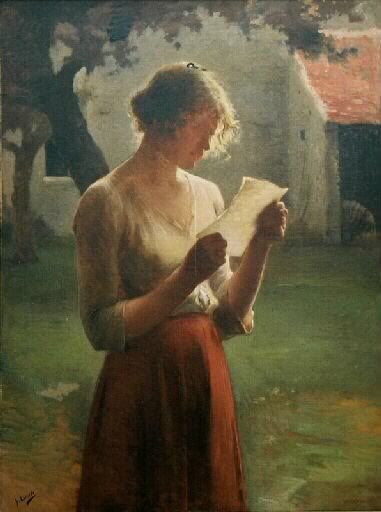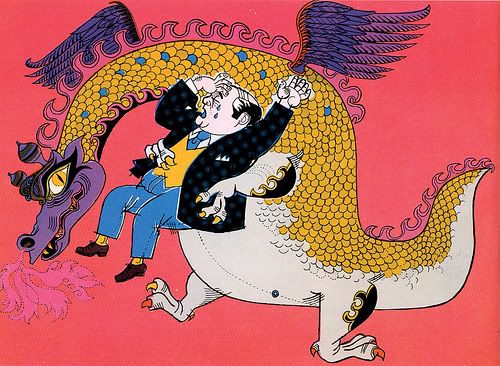 (image: La Lettre by Henry Lerolle (Paris, 1848-1929) via Guarda chi legge)
(image: La Lettre by Henry Lerolle (Paris, 1848-1929) via Guarda chi legge)14. Etcetera And Otherwise by Sean Stanley (Illustrations by Kristi-Ly Green). This little fantastical (he uses the term fabulist, a lot) book with surreal black and white illustrations (collage and painting incorporating vintage engravings in the surrealist tradition*) tells the tale of bookstore owner dubbed Otherwise who goes on a 28 day adventure with beautiful customer Etcetera. It is a bizarre sort of love story - like a relationship/cross-country road-trip related through the lens of the absurd. There are some dramatic images in this surreal world, and interesting characters. Each day (or chapter) begins with with a quotation from Errors in Composition by Duncan Robertson (which may or may not be a real book - I have not bothered to check). I liked parts of this book, which is what I get for choosing a book based on its design.
15. The Stuff of Thought: Language as a Window into Human Nature by Steven Pinker. I guess I had enough of nonsense and moved onto non-fiction. This book is excellent. Any concerns that it would be too dense to read in bits and pieces on the streetcar were alleviated by his clear, engaging and sporadically colloquial style. He investigates how we use language (in particularly, subtleties of grammar) and what this reveals about our primordial systems for categorizing the world as we know it. He is just as likely to allude to contemporary studies in psychology, ethnology or neurology as he is to allude to the Simpsons, comics, movies, or jokes, which makes this book fun to read. I learned a great deal about grammar, which was distinctly more interesting than that may sound. The discussion of Linguistic Determinism (the idea that our language limits thinkable thoughts) and why he thinks that is nonsense, is fascinating. (This reminded me of arguing with Mrs. McRae in grade 11, who claimed that in Nineteen-Eighty Four, the reduction in allowed language would prevent members of their society from thinking certain things. I thought this was a bias of a language-dominant brain in an English teacher. She scowled at me when I said that I do not think in words and that words were a meta- level of thought. When placed on the spot to explain how I could think anything other than words, I could only cite images and mathematics, which she dismissed, and a good portion of civilization as we know it, but she seemed bemused that I would argue with her.) I was surprised to learn that many high-profile philosophers subscribe to this idea, though it comes in and out of fashion. How we semantically break up the world around us, how we name things, what metaphors or lies tells us about the mind, and taboos and culture are all elucidated. The taboo chapter was particularly funny. I really recommend this book.
16. The Kite Runner by Khaled Hosseini. Back to fiction. This is an impressive first novel. It tells the tale of Amir, privileged son of a wealthy, demanding, but generous Pashtun father, in Kabul in the mid-seventies. His shadow is Hassan, son of their servant, a loyal and devoted friend, but as a Hazara, he will always be a second-class citizen in Afghanistan. The title comes from Hassan's skill in hunting down defeated kites as Amir's partner in massive kite battles (with strings covered in glass dust for better cutting). Eventually, Hassan and his father move away, and later, Amir and his father escape the worsening conditions in Kabul to make a new life in California. The book begins with Amir being called back to his homeland and goes on to explain why he feel culpable and responsible to do so. It is a story of fathers and sons, friendship, culture, loyalty, violence, deception, war, love and adoption. It is quite a story. I felt that the first half was superior; by the second half, the scaffolding of the plot structure was showing (foreshadowing was a little too obvious). Nonetheless, overall, this is a beautiful book.
17. A Trip to the Stars by Nicholas Christopher. I loved this novel - you should read it. In 1965 in New York, a 10 year-old Enzo finds himself at the planetarium with his only surviving member of his adopted family, his 21 year-old aunt Alma. Enzo is abducted and both their lives change forever, in ways neither they, nor the reader, would ever foresee. Enzo becomes Loren and Alma becomes Mala. Loren grows up in a hotel in Las Vegas surrounded by unusual scholars (of asteroids, Atlantis, memory, and more). Mala works in libraries, for an arachnologist and then becomes a nurse serving in Vietnam, where she meets and then looses the love of her life. This too is a story about adoption, family, feuds and love, but also of the stars, navigation, Classics, spiders, vampires, and Jelly Roll Morton. It is full of rounded and amazing characters. It is really a magical web of ideas and connections, weaving together the life histories and families. I cannot reveal too much - just trust me- this one is worth picking up.
 Drawing on Type by Frank Newfeld. This is a memoir of award-winning illustrator, designer, typographer and book art director Frank Newfeld. I grew up on Alligator Pie, Garbage Delight and to a lesser extend, Nicolas Knock, and Other People, with poems by Dennis Lee and pictures by Frank Newfeld. I am a huge fan of his work.** I enjoyed his memoir. He was born in Chekhoslovakia, though educated in German. His mother had the foresight to get out of Europe before the WWII began, and they moved to England. His first story is quite hilarious: his first commission and an not-unrelated loss of his virginity. He writes himself as quick to make decisions, even bad ones, to busy trying to cover up his bumbling and unerringly bad sense of direction to be anything but fearless, stubborn and argumentative. He gets out of secondary school, too young to enlist, but gets himself affiliated with the local regiment nonetheless. His mother and step-father emigrate to Canada and he joins them (not ready to be parentless at 18). He signs up to serve for Israel on a bit of a spontaneous whim. He is not very well-informed about Israel or the middle east, but lost many members of his extended family to the Holocaust. After getting himself injured he ends up as war artist. He joins a "Canadian" kibbutz, where as an artist, he has some trouble fitting in. Soon he is back in England at art school, where he decides perhaps this is not the life for him. Much to the gain of the publication industry in Canada, he returns to Toronto. The tales of his early career are quite funny. Eventually he finds his niche. He illustrates, designs, teaches art. He rose to be Vice-President of Publishing at McClelland & Stewart, head of the illustration program at SheridanCollege and Co-founder/President of the Society of Typographic Designers of Canada. This book is interesting on many fronts, not least of which is the knowledge he imparts about the book industry (and the Canadian industry and M & S in particular). It was a bit sad to read how he and Dennis Lee were a bad personality match, but the stories about Canadian cultural giants like Jack McClelland or Pierre Berton are fascinating. I enjoyed it.
Drawing on Type by Frank Newfeld. This is a memoir of award-winning illustrator, designer, typographer and book art director Frank Newfeld. I grew up on Alligator Pie, Garbage Delight and to a lesser extend, Nicolas Knock, and Other People, with poems by Dennis Lee and pictures by Frank Newfeld. I am a huge fan of his work.** I enjoyed his memoir. He was born in Chekhoslovakia, though educated in German. His mother had the foresight to get out of Europe before the WWII began, and they moved to England. His first story is quite hilarious: his first commission and an not-unrelated loss of his virginity. He writes himself as quick to make decisions, even bad ones, to busy trying to cover up his bumbling and unerringly bad sense of direction to be anything but fearless, stubborn and argumentative. He gets out of secondary school, too young to enlist, but gets himself affiliated with the local regiment nonetheless. His mother and step-father emigrate to Canada and he joins them (not ready to be parentless at 18). He signs up to serve for Israel on a bit of a spontaneous whim. He is not very well-informed about Israel or the middle east, but lost many members of his extended family to the Holocaust. After getting himself injured he ends up as war artist. He joins a "Canadian" kibbutz, where as an artist, he has some trouble fitting in. Soon he is back in England at art school, where he decides perhaps this is not the life for him. Much to the gain of the publication industry in Canada, he returns to Toronto. The tales of his early career are quite funny. Eventually he finds his niche. He illustrates, designs, teaches art. He rose to be Vice-President of Publishing at McClelland & Stewart, head of the illustration program at SheridanCollege and Co-founder/President of the Society of Typographic Designers of Canada. This book is interesting on many fronts, not least of which is the knowledge he imparts about the book industry (and the Canadian industry and M & S in particular). It was a bit sad to read how he and Dennis Lee were a bad personality match, but the stories about Canadian cultural giants like Jack McClelland or Pierre Berton are fascinating. I enjoyed it.*Amazing how something as anti-tradition can develop tropes and rules and its own tradition.
**Was quite horrified that









No comments:
Post a Comment